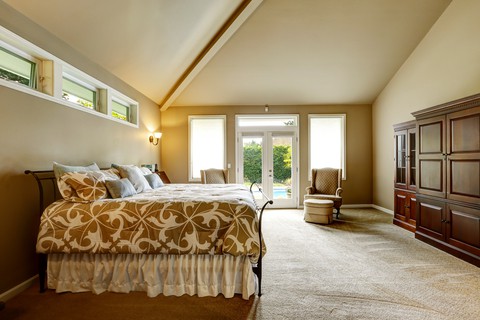High ceilings or cathedral-style rooms look amazing and make any space feel bigger. But, in the winter, they don’t always feel great. We get calls from many homeowners in Eagle, ID telling us that their master bedroom or great room is colder than the rest of the house.
For decades, it’s been a tough problem to solve. In particular, upstairs rooms are often colder than the downstairs in winter. But, today’s HVAC technology has an answer: Ductless heating and cooling in the form of a mini split.
In this article, we’ll go through the reasons why rooms with high ceilings are too cold in the winter. Then, we’ll explain how mini splits work and how they keep these rooms warm.
Meanwhile, if you want to learn more about making your Eagle, ID home more comfortable in the cold weather, call or email us here at Snowflake Air for a free consultation.
Heating Problems In Rooms With High Ceilings
The heating problem in rooms with high ceilings is simple: Hot air rises. So, all the heat you’re pumping into the room collects up near the ceiling. That leaves you, down near the floor, colder than you should be.
 You also get the added problem of where your thermostat is located. Most homes only have one regulating the entire house. But, that’s a problem when different rooms have different temperatures.
You also get the added problem of where your thermostat is located. Most homes only have one regulating the entire house. But, that’s a problem when different rooms have different temperatures.
Let’s say you have a cathedral-style ceiling in your bedroom, but the thermostat is in the living room. That downstairs room, with maybe an eight-foot ceiling, warms up much faster than the upstairs room.
The heater turns off because it thinks the job is done when the gauge on the first floor reaches its call settings. The living room is cozy, but your feet are cold at night.
And, for a long time, there wasn’t much you could do about it. Cranking up the thermostat to heat the upstairs makes downstairs too hot. Any ductwork system pumps all the heat over your head. And, unless you had two furnaces, you couldn’t make a different setting for different rooms.
Space heaters are out of the question. They cost a lot to run, and you can’t leave them unattended since they’re a fire hazard.
Maybe your best bet for a while was baseboard heating. But, as we explored here, even that solution has some limitations.
Fortunately, there’s a system available now that does the job way better than anything else out there.
What is A Mini Split, or Ductless Heating and Cooling?
Ductless heating and cooling uses an outdoor heat pump and air handlers set up in different rooms to warm up any space in your home. They’re often called “mini splits” because of the separate, customizable indoor and outdoor components. They provide more customized heating solutions while costing much less to run than conventional furnaces and ductwork.
Read More: How Do Mini Splits Work?
Three Reasons Mini Splits Are Great For Rooms With High Ceilings
Mini split systems are perfect for rooms with high ceilings because:
- You can install them in one room or all over the house
- Each air handler has its own thermostat
- Air handlers detect and treat cold spots in a room
Single-Zone Vs. Multi-Zone Mini Splits
First of all, you can place an air handler in any room you want. Since they don’t need ductwork, the options are almost limitless.
 With that in mind, you can outfit your entire home with these. Or, install a single-zone system if you only need to take of one room. Mini splits also handle air conditioning, also making them a great way to cool a room with high ceilings in the summer.
With that in mind, you can outfit your entire home with these. Or, install a single-zone system if you only need to take of one room. Mini splits also handle air conditioning, also making them a great way to cool a room with high ceilings in the summer.
Built-In Thermostats
Next, each air handler has a built-in thermostat. Now, it doesn’t matter if you have one unit or five throughout your house. Each air handler operates independently of the others.
That means the unit in your bedroom with the high ceilings may work longer than the one in the living room. Whatever it takes to get the temperature you want.
Detecting Hot And Cold Spots
Finally, these indoor units have high-tech sensors and fans. They locate cold spots within a room and direct the heat toward them.

Compare that to virtually any other heating system! There isn’t another one out there that can get that accurate. And, in a room with high ceilings, that keeps the area near the floor, not up over your head, comfortable.
Read More: How Much Does A Mini Split Cost for Homes in Boise, ID and Valley County?
More Benefits of Ductless Heating And Cooling
Now that we’ve outlined how ductless heating and cooling solves heating problems in rooms with cathedral ceilings, let’s look at a few other overall advantages:
- Quiet Comfort
- Energy Efficiency
- Easy Installation
Read Real Case Studies Of Mini Split Installations In Boise Metro and Valley County
Quiet Comfort
Air handlers are amazingly quiet. Like, library-quiet. So silent you won’t hear them working at all unless there’s no other noise in the room, and you’re standing right under them.
Energy Efficiency
Mini splits use a fraction of the energy that a comparable ducted system or radiator requires. This happens in part because the heat pump transfers heat instead of burning fossil fuels to generate it.
On top of that, the air handlers spend most of the time operating in a low-power mode. They maintain the temperature instead of going from “Off” to “Full Blast” when the temperature dips.
Easy Installation
Whether you’re outfitting the whole house or treating a single room, installation is easy and inexpensive. We don’t need to redesign rooms or build out ductwork. And, with financial incentives and payment plans, excellent comfort is more affordable than you may realize.
Read More: Rebates and Financing Options For Treasure Valley Heat Pump and Mini Split Installations
Mini Split Installation In Eagle, ID
If you want to make your house more comfortable than ever this winter while saving money on your utility bills, call or email Snowflake Air today! Starting with a free consultation, we’ll help you decide if a mini split installation in your Eagle, ID home is the best option for your Eagle, ID home.




